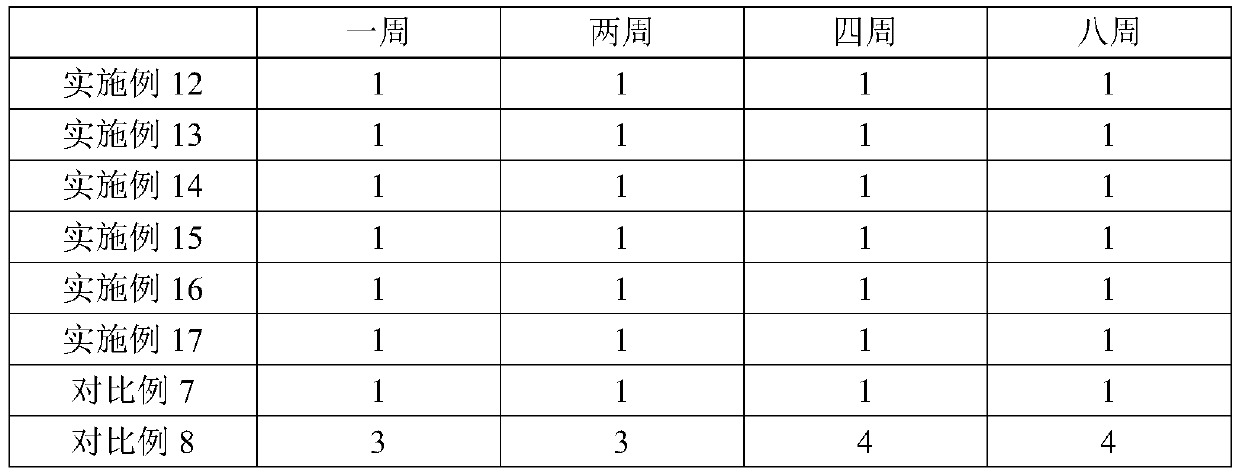Defoaming agent for transparent liquid detergent
A technology of transparent liquid and antifoaming agent, applied in the directions of liquid degassing, foam dispersion/prevention, chemical instruments and methods, etc., can solve the problems of affecting the turbidity of liquid detergents, difficult to express the effect of foam control, and attenuation of foam suppression performance. , to improve clarity, prevent performance degradation, and reduce viscosity
- Summary
- Abstract
- Description
- Claims
- Application Information
AI Technical Summary
Problems solved by technology
Method used
Image
Examples
Embodiment 1
[0059] 75g of trimethylsiloxy-terminated polydimethylsiloxane with a viscosity of 2000mPa·s, 5g of vinyl-terminated polyorganosiloxane CH 2 =CH(Me) 2 SiO[(Me) 2 SiO] 100 Si(Me) 2 CH=CH 2 Mix well in a beaker, add 0.2g of chloroplatinic acid isopropanol solution catalyst at 100°C; slowly add 9.8g of high-viscosity hydrogen-containing polyorganosiloxane Me with a viscosity of 2000mPa·s 3 SiO(MeHSiO) 10 (Me 2 SiO) 100 SiMe 3 , reacted at 130°C for 3h; finally added 5g of silicone resin (the molar ratio of M to Q was 0.5:1), and the specific surface area of 5g was 90m 2 / g of silicon dioxide, stirred at 100°C for 5h, kept the mixture under vacuum of -0.095MPa for 0.1h, and finally cooled to room temperature to obtain silicone active material A1.
Embodiment 2
[0061] 40g of phenyldimethylsiloxane-terminated polydimethylsiloxane with a viscosity of 3000mPa·s, 30g of vinyl-terminated polyorganosiloxane CH 2 =CH(Me) 2 SiO[(Me) 2 SiO] 200 Si(Me) 2 CH=CH 2 Mix well in a beaker, add 0.01g of chloroplatinic acid isopropanol solution catalyst at 120°C; slowly add 10g of high-viscosity hydrogen-containing polyorganosiloxane HMe with a viscosity of 4000mPa·s dropwise 2 SiO(MeHSiO) 30 (Me 2 SiO) 200 SiMe 2 H, react at 60°C for 4h; finally add 10g of silicone resin (the molar ratio of M to Q is 0.6:1), and the specific surface area of 9.99g is 150m 2 / g of silicon dioxide, kept stirring at 160°C for 1 hour, kept the mixture under vacuum at -0.095MPa for 1.5 hours, and finally cooled to room temperature to obtain organosilicon active material A2.
Embodiment 3
[0063] 80g of propyldimethylsiloxane-terminated polydimethylsiloxane with a viscosity of 6500mPa·s, 17.7g of vinyl-terminated polyorganosiloxane CH 2 =CH(Me) 2 SiO[(Me) 2 SiO] 500 Si(Me) 2 CH=CH 2 Mix well in a beaker, add 0.2g of chloroplatinic acid isopropanol solution catalyst at 80°C; slowly add 0.1g of high-viscosity hydrogen-containing polyorganosiloxane HMe with a viscosity of 8000mPa·s dropwise 2 SiO(MeHSiO) 30 (Me2SiO) 200 SiMe 2 H, react at 150°C for 5.0h; finally add 1g of silicone resin (the molar ratio of M to Q is 0.7:1), and the specific surface area of 1g is 200m 2 / g of silicon dioxide, heat-stirred at 100-160°C for 1-5h, kept the mixture under vacuum of -0.095MPa for 1h, and finally cooled to room temperature to obtain organosilicon active material A3.
PUM
| Property | Measurement | Unit |
|---|---|---|
| specific surface area | aaaaa | aaaaa |
| specific surface area | aaaaa | aaaaa |
| viscosity | aaaaa | aaaaa |
Abstract
Description
Claims
Application Information
 Login to View More
Login to View More - R&D
- Intellectual Property
- Life Sciences
- Materials
- Tech Scout
- Unparalleled Data Quality
- Higher Quality Content
- 60% Fewer Hallucinations
Browse by: Latest US Patents, China's latest patents, Technical Efficacy Thesaurus, Application Domain, Technology Topic, Popular Technical Reports.
© 2025 PatSnap. All rights reserved.Legal|Privacy policy|Modern Slavery Act Transparency Statement|Sitemap|About US| Contact US: help@patsnap.com



